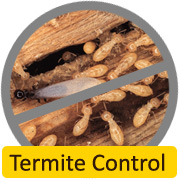 They are small insect look similar like ants but white in color. They can be called as silent killer because they work internally in a sense that we can’t make out any damages created by them in the initial stage. Exposed termites transfer toxicant to nest mates, not directly exposed to soil, causing indirect mortality, i.e. it interferes with the transmission of nerve impulses, stimulating the nerve cells by acting as a receptor protein of the termites.
They are small insect look similar like ants but white in color. They can be called as silent killer because they work internally in a sense that we can’t make out any damages created by them in the initial stage. Exposed termites transfer toxicant to nest mates, not directly exposed to soil, causing indirect mortality, i.e. it interferes with the transmission of nerve impulses, stimulating the nerve cells by acting as a receptor protein of the termites.
Termites can enter a home through a hole of less than 1/64th of an inch
-Termites can go undetected for long periods of time causing serious damage to your home. Termites can work 24 hrs a day and will eat any cellulose-based material which includes: wood, boxes, drywall and even furniture
-These social insects, which live in giant colonies, are a reality better faced up to than ignored. They’re always looking for a fresh house to devour. Yours may be next on their menu, but you don’t have to make it easy for them.
-Termites is a highly destructive group of insect pest, causing major structural timber damage to domestic / commercial buildings. Termite’s cause more damage annually to structures than storms, fires, floods, hurricanes or earthquakes and most natural disasters combined.
-Some people require white ant treatment but termites and ants are quite different insects. Termites are not a member of the ant family but the term white ant is firmly ingrained in the Australian language. Our Termite Inspectors have many years of experience between them. All of our Inspectors are fully qualified.
How to Identify a Termite Infestation:
Termite infestations can cause major damage to buildings and furniture. Most termite infestations are well established before outward signs become visible, but becoming familiar with termite infestation signs may help you identify an infestation and get prompt treatment.
Steps:
1. Watch for winged termites swarming from inside a building, which indicates a termite infestation.
2. Place a winged termite in a vial or small jar with rubbing alcohol. If you don’t have those supplies available, scoop the termite into a small, sealable plastic bag. Take the sample to an exterminator or a government or university extension office that can identify whether or not you found a termite
3. Look for dirt tubes underground in the foundation or exterior walls.
Subterranean termites construct mud tubes to provide themselves with a safe environment while travelling from their underground colonies to their food sources. They may also be found in support piers and floor joists for tubes. Dirt tubes are brown and generally the diameter of a pencil or pen, though some may be larger
4. Cut open any dirt tubes you find. Look for termites. Generally you will find workertermites, which have small, whitish translucent bodies. If you don’t see termites, they may have abandoned that particular tube and you may still have an infestation
5. Take note of any damaged wood. Cracks in veneer or maze like tunneling can indicate a drywood termite wood infestation. Subterranean termites hollow out wood along the grain and you will find dried mud or soil inside
6. Check for sunken or rippled wall coverings. Sometimes depressions will occur due to termites burrowing underneath the wall coverings
7. Search for small holes on drywall or plaster walls. Holes caused by termite infestations will have dirt around the edges.
8. Inspect any areas that appear to have water damage. Termite damage can be similar in appearance and include swollen floors or ceilings and buckling boards or windowsills. Termite infestations may also give of a mold or mildew scent.
9. Look for fecal pellets. Drywood termites, which usually live within walls or furniture, form colonies within wood. They create holes to force out their waste and leave piles of fecal pellets near the holes. Check furniture or walls for small holes. The holes will usually be discolored and sealed from the inside. See if there are small piles of fecal pellets near the holes. Drywood termite fecal pellets are usually dry, smooth and powdery looking and can be many different colors
10. Sweep up the fecal pellets and dispose of them. Check the spot daily to see if more fecal pellets appear. If not, the termites may have died out or moved on to a new colony
11. Tap wood furniture to see if any fecal pellets fall out of small holes. If you see small holes, or maze-like tunneling in furniture, wooden floors or walls, tap firmly to see if any fecal pellets fall out of the holes. Many antique or older pieces of furniture will have holes or tunneling, but not be currently infested, but fecal pellets are a sign of a current infestation
